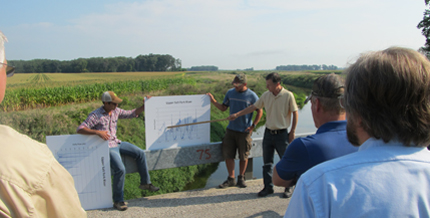Soil Science Society of America
5585 Guilford Road • Madison, WI 53711-5801 • 608-273-8080 • Fax 608-273-2021
www.soils.org
Twitter | Facebook
NEWS RELEASE
Contact: Hanna Jeske, Associate Director of Marketing and Brand Strategy, 608-268-3972, hjeske@sciencesocieties.org
Nitrogen in a "mo fo lo po" world
April 7, 2015 - Nitrogen is a critical element to growing healthy food. It’s a nutrient that helps plants grow. It’s the elemental backbone of proteins. However, managing nitrogen levels in soils has created debate over the decades. Recently, a group of scientists, industry representatives, farmers, and government and non-government organization members met to discuss managing nitrogen on farms with the goal of “Mo Fo Lo Po:” more food, low pollution.
Eric Davidson, a professor and scientist at the University of Maryland Center for Environmental Science, led the effort to publish findings from the meeting in the Journal of Environmental Quality.
 “Society needs to feed about 9.5 billion people by 2050, yet maintain healthy soil and water resources,” says Davidson. “Fortunately, the ‘Mo Fo Lo Po’ goal is easy to articulate and understand.” The knowledge and technology are there. But new investments and partnerships in knowledge-based agriculture will be required. “This includes consideration of the socio-economic factors that affect farmer decision making.”
“Society needs to feed about 9.5 billion people by 2050, yet maintain healthy soil and water resources,” says Davidson. “Fortunately, the ‘Mo Fo Lo Po’ goal is easy to articulate and understand.” The knowledge and technology are there. But new investments and partnerships in knowledge-based agriculture will be required. “This includes consideration of the socio-economic factors that affect farmer decision making.”
In the early 1900’s, an innovation called the Haber-Bosch process allowed engineers to take nitrogen from the air and produce chemical synthetic nitrogen fertilizers. This solved the challenge of maintaining nitrogen-rich soil. As a result, farmers can grow more food to feed an expanding world population. “There are still about 1 billion undernourished people in the world,” notes Davidson. “But we are, on average, better nourished than at any time in human history. The work of a single farmer in the developed world can feed more than one hundred people. This allows most of us to pursue other professional, economic, and cultural endeavors.”
The use of adding synthetic or organic nitrogen to feed an expanding population can have consequences by pollution. Some forms of nitrogen are lost to groundwater and surface water, contributing to algal blooms. Other forms are lost to the air, and can contribute to greenhouse gases. Neither society nor farmers want these unintended consequences. Yet the world needs more food for a growing population.
“Our group had several findings,” adds Charles Rice, professor at Kansas State University and the co-coordinator of the conference. “Farmers get most of their information about fertilizer management from private sector crop advisers. Partnerships are needed in many areas.
Collaborations between government extension and the crop advisers could help get up-to-date information to farmers. Government at all levels must restore investments in research, education, and extension. This should advance the adoption of innovative and more nitrogen-efficient crop and animal production systems. Results of these improved practices on the farm will potentially mean less pollution flowing to both downstream and downwind environments.
There is good news. “In the USA, fertilizer nitrogen use has leveled off, while crop yields continue to increase,” says Rice. Further improvements in nitrogen use efficiency (NUE) are needed to create win-win outcomes for both the farmer and the environment. The result could be increased yields and profitability while decreasing the amount of nitrogen lost to the environment: the Mo Fo Lo Po mantra.
To read the Journal of Environmental Quality special section on Nitrogen Use Efficiency, visit https://dl.sciencesocieties.org/publications/jeq/articles/44/2/305.
Agronomy Journal is the flagship journal of the American Society of Agronomy. Articles convey original research in agriculture, natural resources, soil science, crop science, agroclimatology, agronomic modeling, production agriculture, and instrumentation.